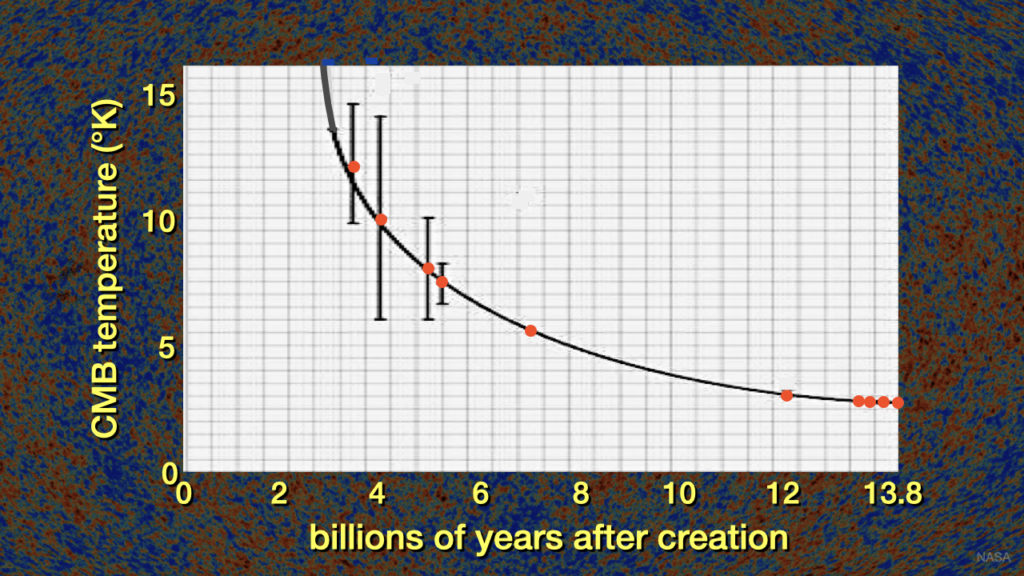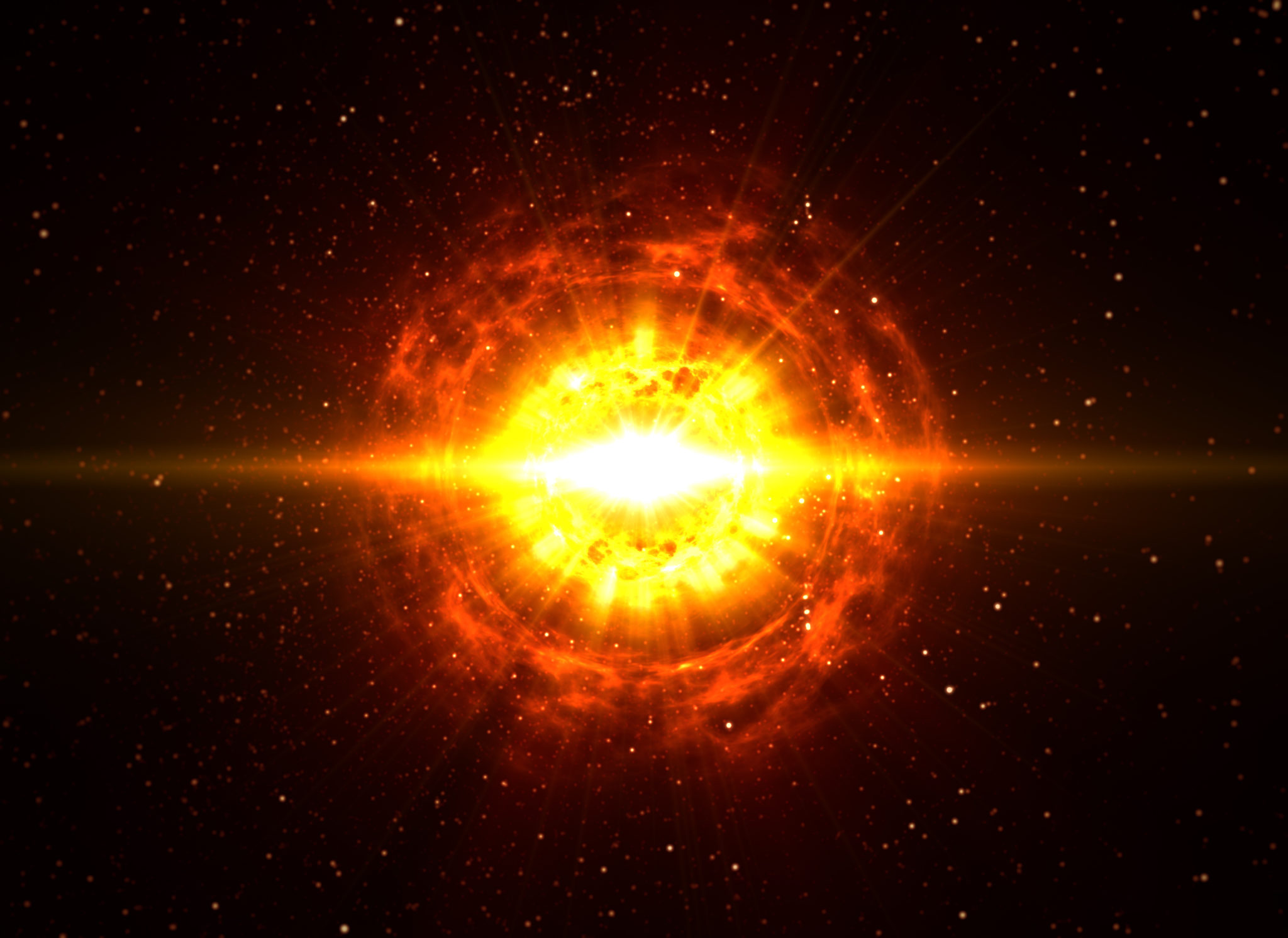Taking the Big Bang’s Temperature
During my teens and twenties, the lead into a frequent summer joke punchline was as follows: “It sure was hot today.” “How hot was it?” “It was so hot that . . .” While Earth’s surface temperature is easy and straightforward to measure, it is very challenging indeed to measure the temperature of the universe, especially its past temperature.
Despite the challenges, astronomers are keenly interested in obtaining measurements of the universe’s temperature throughout its history because those measurements deliver an enormous payoff, both scientifically and theologically. They provide the most definitive, direct, and unambiguous test of the biblically predicted big bang creation model.1
Present-Day Cosmic Microwave Background Radiation Temperature
In 1964, Bell Labs astronomers Arno Penzias and Robert Wilson serendipitously made the first-ever measurement of the temperature of the cosmic microwave background radiation (CMBR).2 They scooped Robert Dicke, James Peebles, P. G. Roll, and David Wilkinson at Princeton University who had just finished building a radiometer for the express purpose of detecting this radiation. Penzias and Wilson did not fully realize the significance of their discovery, so they contacted Dicke for an explanation of the excess background radiation they had detected. Dicke explained to them that they had discovered the long-sought radiation left over from the big bang creation event.3 Penzias and Wilson’s discovery was the first direct evidence that the universe indeed arose from a big bang creation event, a discovery that won them a Nobel Prize in physics.
The temperature measurement published by Penzias and Wilson was 3.5 ± 1.0 K, that is, 3.5 ± 1.0oC above absolute zero. Since 1964, astronomers have measured the temperature left over from the big bang with increasing precision. The best current measurement is 2.72548 ± 0.00057 K.4
Past CMBR Temperatures
In the big bang cosmological creation model, the universe at the creation event is understood to be infinitesimally small in volume and nearly infinitely hot. As the universe expands from the cosmic creation event, it cools down in a highly predictable manner. According to the big bang model, the past temperature of the CMBR will be its present temperature multiplied by 1 + r, where r is the redshift at which the CMBR temperature is being measured. Redshift occurs when cosmic expansion stretches the light wavelengths emitted by an astronomical body. The greater the velocity of an astronomical body moving away from us as a result of the expansion of the universe, the more toward the red end of the spectrum that body’s spectral lines will be shifted. The redshift of an astronomical body is directly related to its lookback time, that is, how far back in time astronomers are observing light emitted by the astronomical body.
In the spectra of the interstellar medium in galaxies and quasars lie certain spectral lines whose line strengths depend on the CMBR temperature. By measuring these strengths and determining the redshifts of the spectral lines, astronomers can determine how well their measurements fit the predicted past temperatures of a big bang universe. It is precisely these measurements that yield the most definitive and unambiguous test of the big bang creation model.
In the fourth edition of my book, The Creator and the Cosmos, I present a figure (reproduced here) that shows the predicted temperature cooling curve of the universe’s CMBR overlayed by actual measurements astronomers have made of the CMBR’s past temperatures. The figure shows a remarkably close fit between actual CMBR temperature measurements and past CMBR temperatures predicted by the big bang creation model.

The curve is the predicted cooling of the universe according to the big bang creation model with a cosmic age of 13.79 billion years and an average cosmic expansion rate at 68.65 kilometers/second/megaparsec. The dots and error bars are actual temperature measurements of the CMBR made at different distances or lookback times. Credit: Reasons to Believe
The measurement in the middle of the curve of the figure corresponding to 7 billion years ago is the most accurate temperature measurement in deep time.5 The error bar on this measurement is less than the thickness of the line showing the predicted cooling curve, and this measurement sits right on the predicted cooling curve. In the words of seven astronomers who published a detailed study of the cooling of the CMBR temperature, “No significant deviations from the redshift dependence of the CMB temperature predicted in the standard model have been found.”6
CMBR Temperature Measures Near the Cosmic Creation Event
An examination of the figure shows that no CMBR temperature measurements are available for lookback times greater than 10.3 billion years. That is, there are no CMBR temperature measurements for the first 3.5 billion years of the universe’s history.
Until recently, no telescope was powerful enough to measure the CMBR temperature in the interstellar medium of galaxies more distant than 10.3 billion light-years. Now, several telescopes possess that power, as evidenced by the following two studies.
In the November 2020 issue of Astronomy Letters, a team of five astronomers published their measurements of the CMBR temperatures in the interstellar medium of 15 different galaxies spanning the redshift range of 1.7 to 3.3.7 This redshift range corresponds to lookback times of 9.89–11.82 billion years or 1.97–3.90 billion years after the cosmic creation event. To determine the present temperature, for each galaxy, they used the formula TCMBR = T0(1 + z) where TCMBR is the temperature of the CMBR in the interstellar medium of the galaxy and T0 is the present-day CMBR temperature. They then averaged the 15 determined T0 values and compared that average with the best present-day measurement of 2.72548 ± 0.00057 K. The averaged T0 value based on the 15 galaxies was 2.719 ± 0.009 K. This independent measure of the CMBR temperature at the present epoch is in excellent agreement with the direct measurement of the present epoch CMBR temperature. This achievement stands as a powerful affirmation of the big bang creation model during an epoch of cosmic history that had not previously been investigated.
In the February 3, 2022, issue of Nature, a team of eight astronomers achieved a measurement of the CMBR temperature in the interstellar medium of a galaxy with a redshift of 6.34.8 This redshift corresponds to a lookback time of 12.90 billion years ago or just 0.89 billion years after the cosmic creation event. At this redshift, the CMBR temperature based on the big bang creation model is 20.005 K. The CMBR temperature measurement made on the galaxy at redshift 6.34 was 23.3 ± 6.9 K. Again, the measurement agrees with the value predicted by the big bang creation model.
An examination of the figure and the results from the studies published in 2020 and 2022 indicates that the measurements fit the predicted cooling curve from the big bang creation model to a degree that is consistently much better than one would expect from the published error bars. Therefore, it is likely that the error bars are too conservative.
What’s Next
The two studies were the first such studies that tested the big bang creation model at epochs corresponding to the formation of the earliest galaxies. Now, the James Webb Space Telescope that stands ready to begin serious astronomical observation is ideally suited to accurately measure CMBR temperatures in such galaxies. We can soon look forward to high-precision tests of the cooling of the CMBR temperature predicted by the big bang creation model.
Theological Implications
While even more definitive tests of the big bang creation model will be forthcoming, already the big bang creation model has exhaustively withstood and passed every conceivable test that could be marshaled against it. There is no longer any rational basis for doubting that the universe arose from a big bang creation event, just as dozens of different passages of the Bible predicted more than two millennia ago. There is only one rational explanation for how the Bible possesses such amazing predictive power. It must be inspired by the One who created the universe.
Endnotes
- Hugh Ross with John Rea, “Big Bang—The Bible Taught It First!,” Reasons to Believe (July 1, 2000); Hugh Ross, “Does the Bible Teach Big Bang Cosmology?,” Today’s New Reason to Believe (blog), Reasons to Believe, August 26, 2019.
- Arno A. Penzias and Robert W. Wilson, “A Measurement of Excess Antenna Temperature at 4080 Mc/s,” Astrophysical Journal 142 (July 1965): 419–421, doi:10.1086/148307.
- Robert H. Dicke et al., “Cosmic Black-Body Radiation,” Astrophysical Journal 142 (July 1965): 414–419, doi:10.1086/148306.
- D. J. Fixsen, “The Temperature of the Cosmic Microwave Background,” Astrophysical Journal 707, no. 2 (December 20, 2009): 916–920, doi:10.1088/0004-636X/707/2/916.
- S. Muller et al., “A Precise and Accurate Determination of the Cosmic Microwave Background Temperature at z = 0.89,” Astronomy & Astrophysics 551 (March 4, 2013): id. A109, doi:10.1051/0004-6361/201220613.
- I. de Martino et al., “Measuring the Redshift Dependence of the Cosmic Microwave Background Monopole Temperature with Planck Data,” Astrophysical Journal 757, no. 2 (September 12, 2012): id. 144, p. 1, doi:10.1088/0004-637X/757/2/144.
- V. V. Klimenko et al., “Estimation of the Cosmic Microwave Background Temperature from Atomic CI and Molecular CO Lines in the Interstellar Medium of Early Galaxies,” Astronomy Letters 46 (November 2020): 715–725, doi:10.1134/s1063773720110031.
- Dominik A. Riechers et al., “Microwave Background Temperature at a Redshift of 6.34 from H2O Absorption,” Nature 602 (February 3, 2022): 58–62, doi:10.1038/s41586-021-04294-5.





